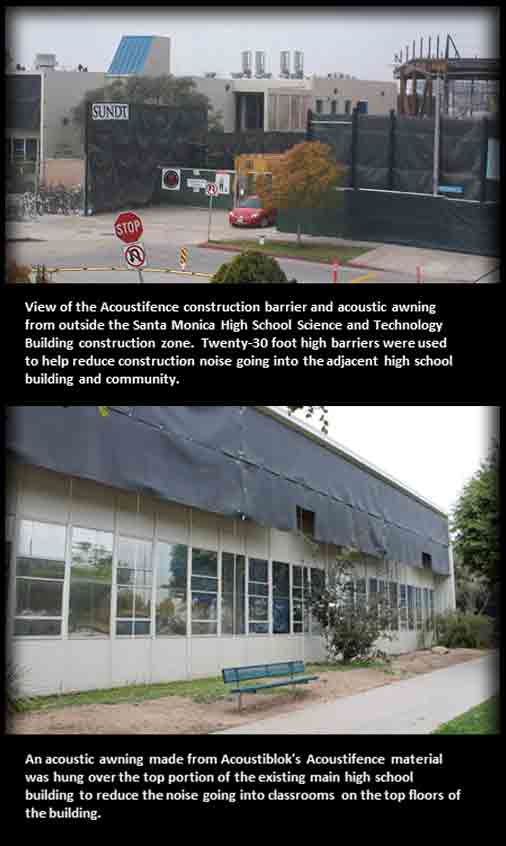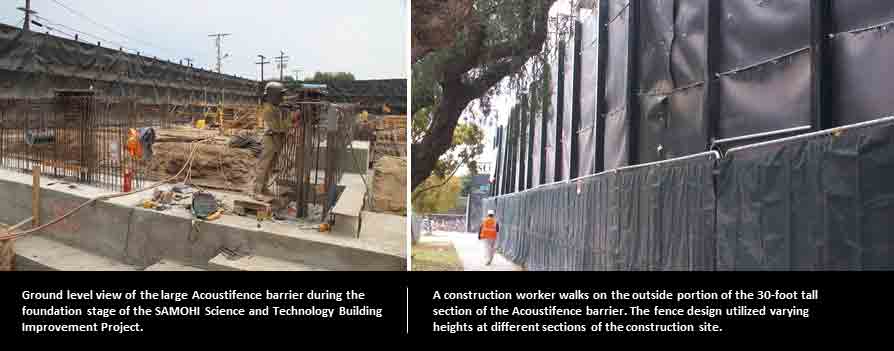AcoustiFence Reduces Construction Noise
AcoustiFence® School Construction Zone Noise Reduction Project
SANTA MONICA, CALIF., May 21 – A towering and stout zig zag-shaped construction fence that spans nearly 800 feet long and is lined with Acoustiblok, Inc.’s Acoustifence soundproofing material at the Santa Monica High School (SAMOHI) Science & Technology Building Project has helped reduce construction noise for students and the local community by 10 decibels each day over the past two years. A 10 decibel decrease in sound level cuts perceived loudness to the human ear in half, making this black colored acoustic fence very “green.”If all sections of this acoustical construction fence were linked together in a line, it would span nearly two and a half football fields and be as tall as a two to three story commercial building in some sections. Why is this much fencing needed? This three year, $55 million improvement project entails reconfiguring a 5.2-acre northern portion of the existing 26-acre school campus. The school is located in a densely populated area of posh Santa Monica near businesses and residential dwellings.
An existing softball field was demolished and a new modern 97,000 square-foot science and technology building is being built in its place. Once completed, the old science and technology building will be demolished and a new softball field will be built in its place. The Acoustifence construction barrier will moved and reused to mitigate noise escaping to the nearby neighborhoods during various phases of the project. Additional outdoor site improvements are being constructed as well on the SAMOHI campus. The construction project began in December and is scheduled to be completed in 3 winters. It is approximately 48 percent complete at the time of the writing of this news article.
Acoustifence is a modern day acoustical soundproofing product developed by Tampa, Fla.-based Acoustiblok, Inc. It’s an advanced material sound barrier that is placed between a noise source and the noise receiver. The Acoustifence material easily attaches to chain link fences and comes in large sections and in custom made sizes, making it ideal for construction fence applications that require a soundproofing element at the construction site. Acoustifence material is extremely strong and was engineered to withstand harsh outdoor environments like construction sites and highway environments. Full exposure to dirt, grease, oil, mold or even being driven over is not a problem for the Acoustifence.
The word “green” refers to environmentally-preferable attributes of a product, service, and/or technology. The 1/8” thick Acoustifence is a unique proprietary formula. It is a heavy mineral filled viscoelastic polymer material that is made in the United States from all USA made material. Acoustifence is 100 percent made in the United States. It does not contain lead, asbestos, or barium and is UV-resistant and impervious to water and mold. Graffiti, a real consideration in a school area, is easily removed compared to other surfaces. Acoustifence has had proven success in many demanding applications and is an effective defense against outdoor noise pollution.
A construction project this large isn’t simple or easy. It’s messy, noisy and can disturb the usual flow for people around the construction site. The school district was committed to minimizing disruption to students, staff and nearby neighbors during the construction. Mitigating construction noise and dust going into the school and neighborhoods located directly across the street had to be addressed by project planners. The main high school building is located within very close proximity of the construction area. Single family homes, apartment complexes and businesses are located in areas across the street from the campus.
Project planners decided early on that acoustical barriers will be in place to reduce noise levels for classrooms and neighbors and that the construction area will be separated from the working campus by a safety fence and that
“This 5.2-acre construction site is very spread out. Controlling noise from heavy machines, demolition, and construction activities can be challenging at large construction sites located in densely populated areas,” said Glenn Nadalet, Senior Construction Manager for Parsons/CCM.

AcoustiFence Reduces Construction Noise

Two sides of the Acoustifence barrier are being used to protect the neighborhood and the other portion protects the school. Temporary chain link construction fencing is commonly used at construction sites to help prevent theft and damage to machinery, equipment, and property, as well as provide security for the construction crew.
Construction noise may negatively impact those around a construction site. The SAMOHI construction project Acoustifence ranges in height from 14-20 feet at different parts of the construction site and zigzags around the perimeter near the street and the existing school building. In addition to the construction fence, Acoustifence soundproofing material was draped over the side of the top portion of the school building to help make the second floor quieter for students during construction.“Our heavy equipment machines emit between 90-100 decibels of noise while operating depending on the machine itself. Throughout the day, these machines are sometimes located 250-300 feet away from the school building making it virtually impossible to contain all the noise,” Nadalet said.Heavy equipment machines are needed to build large buildings and rebuild a large area like at Santa Monica High School. According to the U.S. Environmental Protection Agency, noise from various construction machines can range from 70-95 decibels at 50 feet. One front loader can reach approximately 83 decibels; scrapers, graders and backhoes approximately 92 decibels; concrete mixers and cranes approximately 88 decibels, earth moving tractors can reach approximately 95 decibels. A single jackhammer can reach nearly 100 decibels and a pile driver reaches approximately 105 decibels. So a 10-decibel decrease in construction noise significantly helps to keep it within a more tolerable range.“The Acoustifence noise barrier wall is located about 10 feet from the school building so our machines are not always located within close proximity to the noise barrier fence. We work hard to keep construction noise as minimal as possible while moving the project forward to meet our deadlines,” Nadalet said.
Noise intensity is measured in decibel units. The decibel scale is logarithmic; each 10-decibel increase represents a tenfold increase in noise intensity. Human perception of loudness also conforms to a logarithmic scale; a 10-decibel increase is perceived as roughly a doubling of loudness and a 10-decibel decrease is perceived as half as loud. A typical conversation occurs at 60 decibels – not loud enough to cause damage. If a sound reaches 85 decibels or stronger, it can cause permanent damage to a person’s hearing with prolonged exposure. The amount of time a person listens to a sound affects how much damage it will cause.
“The Acoustifence is psychologically positive for the students, teachers and administrators at the school. It gives them confidence that we are taking care of their noise concerns. We believe we get about a 10 decibel decrease in construction-related noise for the neighbors and school with the Acoustifence barrier,” Nadalet said.
Acoustiblok now also produces beautiful landscape covers for its fences. Since the covers are an actual photograph of different scenery, such as foliage, flowers, brick, or stones, it is virtually indistinguishable and many say better than real life.
Acoustiblok’s Chief Operating Officer who worked on the Santa Monica Fence project: “All our noise barrier products are affected by where they are positioned in reference to the noise source, the distance between the noise source and the noise receiver, the height of the barrier, and the type of environment they are in. The amount of noise Acoustifence reduces is also much related to other reflective structures in the area,” she said.
The Public Works Division of FenceCorp, a leading California fencing company based in Riverside, Calif., won the bid to install the large temporary acoustic fence for the project. Acoustiblok’s Acoustifence material was considered to be the best choice for its proven performance and ease of installation.
Ira Schechtel, Manager of FenceCorp’s Temporary Rental Fence Division at the Oceanside, Calif. Branch, helped oversee the work. He was heavily involved in the bidding and administrative aspects of the project. Schechtel is an experienced fence professional with 30 years experience in the fence industry. He is also the former president of the California Chapter of the American Fence Association.
“Because the cost and human effort associated with the acoustical fence is higher than a typical chain link fence, it was important that we not make mistakes when we built it. We have to do things right the first time to avoid costly mistakes with these types of fences. A mistake on an acoustical fence is much more substantial in terms of dollars per section than typical chain link fences.”
A fence of this magnitude would be a significant financial loss if it failed to adequately reduce noise. To ensure results, Acoustiblok Corporation’s engineering department uses acoustical outdoor modeling software to accurately predict the acoustical results in advance. The software, called Cadna A, was developed in Germany to create cities with reduced noise levels and is considered the most advanced of its kind.
Schechtel and vice presidents Perry Massie and Alan Kay, and Superintendent Kenny Kocek helped oversee the bidding and installation of the Santa Monica Construction Fence project. “The bidding and installation process for a large specialized fence like this takes more time and effort than people may think. Due to the height of the barrier walls, we engineered the large posts and cables to specifically hold the dense and flexible acoustical fence. Even the barriers on the existing building were specifically designed for Acoustifence. It truly takes a team effort to do these things right and be successful in the fencing business.”
“As we do more Acoustifence projects, we are learning what to look for in advance. Each Acoustifence project has its own unique set of environmental, noise and design challenges with our customers. This is not a one size fits all fencing application. There’s more science to them and to be effective, they have to be positioned in the right places around the noise sources. This just adds to our capabilities,” Schechtel added.
Acoustifence is an effective soundproofing solution because it’s a thin outdoor noise blocking material which acoustically performs precisely as lead does, but without the environmental hazard of lead said Myers. Acoustifence comes in 6 X 30 foot sections considered the most effective first step in reducing noise. It’s now being widely used in construction and building environments, at industrial facilities to quiet generator and motor noises, for mass transit rail lines, residential, and in many other outdoor applications where noise has been an unresolved problem she said.
Lahnie Johnson is President and founder of Acoustiblok, Inc. He drives new product development at Acoustiblok. “Acoustical soundproofing materials and products like Acoustifence, Acoustiblok, QuietFiber, and our indoor and outdoor All Weather Sound Panels compete in specialized niche markets,” he said.
“People are becoming more aware of noise problems and the stress it causes them. Santa Monica High School is just one example. With greater population density and increasing noise pollution and noise control regulations being passed by local, state and federal governments, the soundproofing products and services market is continually on the rise and we’re here to help meet their needs.”
About Acoustiblok
Acoustiblok Corporation, a NASA Spin-off listed company headquartered in Tampa, FL, provides acoustical soundproofing solutions for noise related issues. The company develops, manufactures, and markets acoustical products, earning the industry’s highest ratings from architects, builders, and consumers. Acoustiblok ships soundproofing products to 60 countries around the world.
